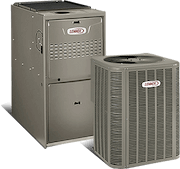
If you are familiar with geothermal heat pumps, you may already know that they take heat from the earth. Geothermal literally translates to “earth heat” as geo means earth and thermal of course refers to anything involving heat. Geothermal heat pumps are becoming quite popular in many parts of the world as the energy they use is a renewable, alternate source of energy, unlike the fossil fuels we generally use in the furnace. But, how does a geothermal heat pump work even when it’s cold outside?
To learn more about how a geothermal heat pump works in comparison to gas and electric furnaces, contact us at 314-993-1110.
What is A Geothermal Heat Pump?
The earth absorbs a lot of heat from the sun during the day. This heat is stored in the ground and gradually dissipated. But a major portion of it is trapped in the layers of the earth. This energy is known as geothermal energy. A geothermal heat pump draws this heat from the ground and delivers it to your home.
Usually, there is a ground loop system consisting of a heat exchanger and ductwork for carrying air. The heat exchanger has tubes filled with fluid that reach deep underground and capture the heat from the earth. The fluid gets heated and transfers this heat to the air circulating through the ducts in the heat exchanger. So the cold air is suctioned from inside the house, heated by the fluid, and delivered back into the house.
Geothermal heat pumps are considered an environmentally friendly way of heating homes as they use clean, renewable energy.
How Does A Geothermal Heat Pump Work During Winters?
During winters, particularly in places that experience heavy snowfall, it seems unlikely that geothermal heating systems would work. The ground is covered by thick layers of snow and the temperature outside is already very low. But a geothermal heat pump is still seen to work fine.
That is because below the frost line the temperature of the ground is almost steady throughout the year. No matter how much snowfall you have had, you can still extract heat from the ground from below the frost line and the geothermal pump can work at the same efficiency.
Vertical vs. Horizontal Geothermal Heating Systems

The loops in the underground unit of the geothermal heat pump can be placed either vertically or horizontally. Horizontal loops can cover more area without having to dig too deep into the ground. But they require a lot of space as well. If your premises are small, a horizontal loop geothermal heat pump will not work for you.
Vertical loops on the other hand can go as deep as 400 feet. Deeper loops provide a more consistent temperature as they are not affected by the changes above the ground. So, they are likely to be more efficient.
Choosing between horizontal and vertical loop geothermal heat pumps depends on a lot of factors though. From the costs of digging the trenches to the soil quality to the climate, there are many things that can affect the decision.
Consult HVAC Experts to Learn More About How Geothermal Heat Pumps Work
If you are getting an HVAC system installed or want to learn more about how geothermal heat pumps work, and if one may be an energy efficient heating option for your home, contact our St. Louis heating and air conditioning experts today online or by phone.









